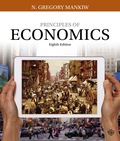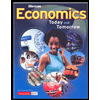
The supply of money in the economy.
Answer to Problem 1CQQ
Option 'c' is the correct answer.
Explanation of Solution
Any commodity or item that a community accepts as payment for the goods and services is known as money. It can be any commodity that the consumer gives in exchange for goods and services. The banks are financial institutions that play an important role in a financial market.
Option (c):
The use of the lines of credit which are accessible with credit card cannot be considered as money supply because it is a debt instrument and there is no supply of money. Therefore, the lines of credit accessed through credit card are not included in the money supply. Thus, option 'c' is correct.
Option (a):
The metal coins are a form of money that is used by an economy for the purpose of the exchange of goods and services. They are accepted as payment for the goods and services. Hence, they are included in the money supply. Thus, option 'a' is incorrect.
Option (b):
Paper currency is a widely accepted form of money all over the world. Hence, it is included in the money supply of the economy. Thus, option 'b' is incorrect.
Option (d):
Bank balances that are accessible with debit cards are the savings of the customers and they are included in the money supply of the economy. When the bank balance increases, the money supply increases, and vice versa. Thus, option 'd' is incorrect.
Concept introduction:
Money: Money is any item that is accepted as payment for the goods and services provided by an economy.
Banks: Banks are financial institutions that accept deposits of money from the general public and use it to provide loans to the public.
Want to see more full solutions like this?
Chapter 29 Solutions
EBK PRINCIPLES OF ECONOMICS
- You are the manager of a large automobile dealership who wants to learn more about the effective- ness of various discounts offered to customers over the past 14 months. Following are the average negotiated prices for each month and the quantities sold of a basic model (adjusted for various options) over this period of time. 1. Graph this information on a scatter plot. Estimate the demand equation. What do the regression results indicate about the desirability of discounting the price? Explain. Month Price Quantity Jan. 12,500 15 Feb. 12,200 17 Mar. 11,900 16 Apr. 12,000 18 May 11,800 20 June 12,500 18 July 11,700 22 Aug. 12,100 15 Sept. 11,400 22 Oct. 11,400 25 Nov. 11,200 24 Dec. 11,000 30 Jan. 10,800 25 Feb. 10,000 28 2. What other factors besides price might be included in this equation? Do you foresee any difficulty in obtaining these additional data or incorporating them in the regression analysis?arrow_forwardsimple steps on how it should look like on excelarrow_forwardConsider options on a stock that does not pay dividends.The stock price is $100 per share, and the risk-free interest rate is 10%.Thestock moves randomly with u=1.25and d=1/u Use Excel to calculate the premium of a10-year call with a strike of $100.arrow_forward
- Please solve this, no words or explanations.arrow_forward17. Given that C=$700+0.8Y, I=$300, G=$600, what is Y if Y=C+I+G?arrow_forwardUse the Feynman technique throughout. Assume that you’re explaining the answer to someone who doesn’t know the topic at all. Write explanation in paragraphs and if you use currency use USD currency: 10. What is the mechanism or process that allows the expenditure multiplier to “work” in theKeynesian Cross Model? Explain and show both mathematically and graphically. What isthe underpinning assumption for the process to transpire?arrow_forward
- Use the Feynman technique throughout. Assume that you’reexplaining the answer to someone who doesn’t know the topic at all. Write it all in paragraphs: 2. Give an overview of the equation of exchange (EoE) as used by Classical Theory. Now,carefully explain each variable in the EoE. What is meant by the “quantity theory of money”and how is it different from or the same as the equation of exchange?arrow_forwardZbsbwhjw8272:shbwhahwh Zbsbwhjw8272:shbwhahwh Zbsbwhjw8272:shbwhahwhZbsbwhjw8272:shbwhahwhZbsbwhjw8272:shbwhahwharrow_forwardUse the Feynman technique throughout. Assume that you’re explaining the answer to someone who doesn’t know the topic at all:arrow_forward
 Economics Today and Tomorrow, Student EditionEconomicsISBN:9780078747663Author:McGraw-HillPublisher:Glencoe/McGraw-Hill School Pub Co
Economics Today and Tomorrow, Student EditionEconomicsISBN:9780078747663Author:McGraw-HillPublisher:Glencoe/McGraw-Hill School Pub Co



 Exploring EconomicsEconomicsISBN:9781544336329Author:Robert L. SextonPublisher:SAGE Publications, Inc
Exploring EconomicsEconomicsISBN:9781544336329Author:Robert L. SextonPublisher:SAGE Publications, Inc





